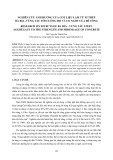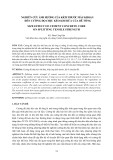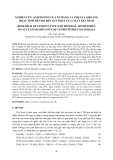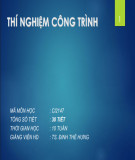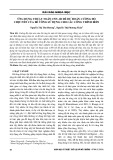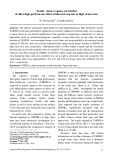
ISSN 1859-1531 - TẠP CHÍ KHOA HỌC VÀ CÔNG NGHỆ - ĐẠI HỌC ĐÀ NẴNG, VOL. 23, NO. 2, 2025 81
STUDY ON OPTIMIZATION OF AL6061 SPHERE SURFACE ROUGHNESS IN
DIAMOND TURNING BASED ON CENTRAL COMPOSITE DESIGN MODEL
AND GREY WOLF OPTIMIZER ALGORITHMS
NGHIÊN CỨU TỐI ƯU HÓA ĐỘ NHÁM BỀ MẶT CẦU AL6061 KHI TIỆN BẰNG
MŨI DAO KIM CƯƠNG SỬ DỤNG MÔ HÌNH THIẾT KẾ TỔNG HỢP TRUNG TÂM VÀ
THUẬT TOÁN TỐI ƯU HÓA ĐÀN SÓI XÁM
Le Thanh Binh, Duong Xuan Bien*, Ngo Viet Hung, Chu Anh My,
Hoang Nghia Duc, Nguyen Kim Hung, Bui Kim Hoa
Advanced Technology Center, Le Quy Don Technical University, Ha Noi, Vietnam
*Corresponding author: duongxuanbien@lqdtu.edu.vn
(Received: Nevember 29, 2024; Revised: Febuary 08, 2025; Accepted: Febuary 11, 2025)
DOI: 10.31130/ud-jst.2025.494E
Abstract - This paper presents optimization results of the Al6061
surface roughness in turning ultra-precision based on the central
composite design method (CCD) and the grey wolf optimization
algorithm (GWO). The experimental matrix is built with three
independent variables including spindle speed, feed rate and
depth of cut. With the experimental data, the roughness regression
model is established. The ANOVA module is used to evaluate the
quality of the regression model. The GWO algorithm is used to
optimize the roughness within the range of pre-determined
cutting conditions. The most reasonable cutting parameter set is
found to ensure that the surface roughness of the Al6061 material
reaches the smallest value. The influence of parameter pairs on
the roughness is analyzed specifically. The research results are of
great significance in improving the surface quality of Al6061
material in turning ultra-precision.
Tóm tắt – Bài báo trình bày kết quả nghiên cứu tối ưu hóa độ
nhám bề mặt cầu vật liệu Al6061 khi tiện siêu chính xác
(SPDT) dựa trên phương pháp thiết kế tổng hợp trung tâm
(CCD) và thuật toán tối ưu hóa đàn sói xám (GWO). Ma trận
thực nghiệm được xây dựng với ba biến độc lập gồm tốc độ
trục chính, tốc độ chạy dao và chiều sâu cắt. Với dữ liệu của
các thí nghiệm, mô hình hồi quy độ nhám được thiết lập. Modul
ANOVA được dùng để đánh giá chất lượng mô hình hồi quy.
Thuật toán GWO được sử dụng để tối ưu hóa độ nhám trong
phạm vi chế độ cắt được xác định từ trước. Bộ thông số cắt hợp
lý nhất được tìm ra nhằm đảm bảo độ nhám mặt cầu đạt giá trị
nhỏ nhất. Ảnh hưởng của các cặp thông số tới độ nhám được
phân tích cụ thể. Kết quả nghiên cứu có ý nghĩa quan trọng
trong việc nâng cao chất lượng bề mặt cầu vật liệu Al6061 khi
tiện siêu chính xác.
Key words - Single-Point Diamond Turning (SPDT); surface
roughness; spherical surface; CCD; GWO.
Từ khóa – Tiện kim cương đơn điểm; độ nhám; mặt cầu; CCD;
GWO
1. Introduction
In the field of ultra-precision machining, achieving a
surface with the desired roughness is a critical requirement
to enhance product quality and meet stringent technical
standards for the operating conditions of specialized
components such as optical lenses, lens molds, spherical
joints, spherical reflective surfaces, and more. Single-Point
Diamond Turning (SPDT) is an advanced machining
method widely used to produce highly precise surfaces (in
the nanometer scale) [1]. Diamond cutting tools are
employed in SPDT to achieve nanometer-level surface
finish with specific requirements such as nanometer-scale
edge sharpness and excellent wear resistance, allowing for
machining with extremely low dimensional accuracy and
surface roughness [2].
SPDT is commonly applied to machine non-metallic
materials (e.g., ZnSe, Ge, CaF2, Si) or non-ferrous metals
such as aluminum and copper. This technology meets the
demands for manufacturing high-precision components,
such as spherical surfaces for optical lenses [3], lens molds
[4], aluminum mirrors [5], and laser guidance systems [6].
Nowadays, SPDT has become increasingly popular,
particularly effective in machining spherical surfaces on
aluminum materials like Al6061. Studies [7] have
demonstrated the excellent machinability (including
surface roughness) of Al6061 spherical mirror surfaces
when altering vibration frequency branching during the
SPDT process.
Surface roughness is a critical technical parameter,
used to measure the surface's unevenness after machining
[8]. Numerous studies have focused on the technical
factors affecting surface roughness, employing various
predictive models, including the Response Surface
Methodology (RSM) [9], Artificial Neural Networks
(ANN) [10], and Adaptive Neuro-Fuzzy Inference
Systems (ANFIS) [11]. Additionally, various algorithms
have been used as tools to solve single or multi-objective
optimization problems based on specific input parameters
and conditions. Frequently applied algorithms include
Genetic Algorithms (GA) [12-14], swarm-based
algorithms (PSO, ACO) [15-16], and the Grey Wolf
Optimization (GWO) algorithm [17-21]. RSM and ANN
modeling [9-10] were described using 27 experiments,
where a first-order regression equation was developed to
predict surface roughness. Furthermore, the GWO
algorithm is widely used for optimizing parameters or






